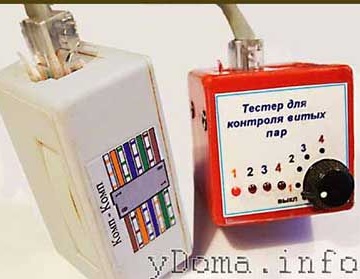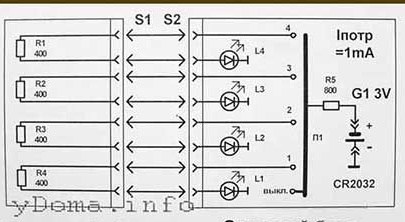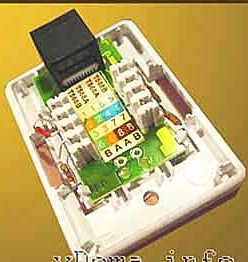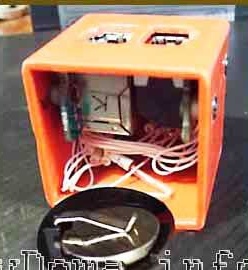
In this article, the author offers a fairly simple design of the twisted pair check unit. Of course, the twisted pair cable diagnostics can be carried out with a conventional tester or multimeter, but with the help of this unit this process will be much faster. With this device, you can diagnose an open and short circuit of twisted pair wires. Such a device can be useful to people involved in laying network equipment, setting up computer networks. You can also use it at home to check the network cable or modem cable. When assembling the block, quite affordable and not expensive components are used.
Device design:
The device consists of two parts, a passive and an active unit. The passive unit serves for closing the contacts of one end of the twisted pair, and the active one for supplying voltage and LED trouble indication.
Here is the connection diagram:

Passive block:
In this case, made from an RJ-45 outlet. Structurally, it consists of a housing, a connector, and four resistors with a resistance of 400 ohms each. Each of these resistors connects one of the four twisted pairs and is needed to limit the voltage passing through the circuit.

Active block:
It consists of a housing, an RJ45 connector, a switch, an 800 Ohm resistor, a battery and four diodes.
The body of the device was made of ordinary plastic children's cube.
The battery used was a 3 volt CR2032 battery. These are used on computer motherboards (you can use two mini finger or finger batteries, but more space will be needed for them). The compartment for its installation was soldered from an unnecessary motherboard.
The cable connector can be removed from a broken network card or other device (modem, router, etc.).
The front panel was drawn on a computer and printed. After it was glued on top to improve the appearance of the device, a transparent tape was pasted.

The principle of operation of the device:
Both blocks are connected from different ends of the twisted pair. The switch on the active unit is set to position “1”.The voltage from the battery inside the unit is supplied to the resistor R 5, after which it is supplied through the connector to one of the twisted pair wires. Further, passing through one of the resistors of the passive block, it is fed to the second wire of the twisted pair, it comes to the LED and it lights up. Switching the switch position to "2", "3" and "4", you can check the remaining pairs of wires.
Cable troubleshooting:
If the LED is lit at normal brightness, there is no problem.
If the LED is lit with high brightness - most likely a short circuit between the wires of the tested twisted pair.
If the LED does not light, a break in one of the wires of the tested twisted pair cable.
The author of the article claims that this device can diagnose a cable connected to active equipment (modem, router, network card, switch, etc.). The device will not harm the equipment, due to the presence in the resistance circuit R5. Depending on the connection diagram inside the device, either two or four LEDs will light. Thus, you can check the quality of the connections in the equipment connector.
